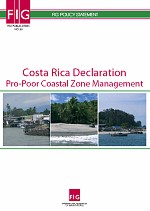FIG PUBLICATION NO. 43
Costa Rica Declaration
Pro-Poor Coastal Zone Management
Contents
Foreword
Acknowledgements
Costa Rica Declaration on Pro-Poor
Coastal Zone Management
1. Introduction
2. Key Conflicts in the Coastal Zones
3. Understanding the Concept of Resilience
4. Managing Land Tenure and Property Rights in
Coastal Areas
5. Managing Access to Land in Coastal Areas
6. Managing Use and Allocation of Land in Coastal
Areas
7. Building the Institutional Capacity
8. Building the Professional Capacity
Glossary of Terms
Orders for printed copies
Photographs in this publication © Stig Enemark, FIG, 2008.
The land-sea interface is one of the most complex areas of management
being the home to an increasing number of activities, rights and interests.
The coastal zone is a gateway to the oceans resources, a livelihood for
local communities, a reserve for special flora and fauna, and an attractive
area for leisure and tourism. Many nations – and especially in the Central
American region – are politically, economically, socially, and
environmentally dependent on the costal zone and proper management of this
fragile environment to meet requirements for sustainability and social
justice.
The coastal areas were therefore chosen as the key theme of the 6th FIG
Regional Conference held in San José, Costa Rica, 12–15 November 2007. Special
attention was given to a pro-poor approach to integrated coastal zone
management, measures for proper land administration, and capacity building in
terms of professional and institutional development.
The theme of Integrated Coastal Zone Management has been widely researched
and documented in publications throughout the world. This publication looks more
specifically at providing a pro-poor approach to managing the interests and
rights in the coastal areas, and the role of the land professionals in this
regard.
This publication stresses a topic of special importance in Central America
but the issue has much wider regional and global implications. FIG as a
Non-Governmental Organisation (NGO) wants to contribute to the global agenda as
represented by the United Nations Millennium Development Goals aiming to
eradicate poverty in all its forms. A pro-poor approach to managing the many,
often conflicting, interests in the coastal zone is therefore of vital
importance. The publication should be seen as a tool to support politicians,
executive managers, professional organisations and decision makers in their
efforts to manage the fragile coastal environment with a special emphasis on
social justice and the livelihood of the local communities.
An expert group appointed at the 2007 FIG Regional Conference in Costa Rica
has prepared the Costa Rica Declaration. Rob Mahoney of FIG Commission 3 chaired
this group. The members of the group were:
- Diane Dumashie, Dumashie Associates, United Kingdom
- Alexander González Salas, Regularisation Programme of Cadastre
and Registration, Costa Rica
- Christiaan Lemmen, International Institute for Geo-Information
Sciences and Earth Observation (ITC), Netherlands
- Rob Mahoney, MahGeo, United Kingdom
- Miriam Miranda, Regularisation Programme of Cadastre and
Registration, Costa Rica
- Michael Sutherland, Department of Surveying and Land Information,
University of the West Indies (UWI), Trinidad and Tobago.
The document is based on the papers presented at the 6th FIG Regional
Conference, 12–15 November 2007, San José, Costa Rica, especially the keynote
presentations given by Ing. Juan Manuel Castro Alfaro, President of
CFIA/CIT, Prof Stig Enemark, FIG President and Mr Fernando Zumbado,
the Costa Rican Minister of Housing. Other keynote presentations at the
conference have also been of great benefit to this publication. These include
papers from Dr. Diane Dumashie, Mr. Alexander González Salas, Dr.
Michael Sutherland, Ass. Prof.
Grenville Barnes, Mr. Stephen T. Mague and Mr. Robert W. Foster.
Conference proceedings are available on-line at:
http://www.fig.net/pub/costarica/
This event chose to focus on key topics for the region – capacity building,
land administration and environmental issues – especially the use and future of
coastal regions. Based on the out-come of the conference the FIG Costa Rica
Declaration outlines where Land Professionals can and should play a key role in
managing and influencing the complex issues of Pro-Poor Coastal Zone Management.
The Costa Rica Declaration was launched at the FIG Working Week in Stockholm,
Sweden, 14–19 June, 2008.
On behalf of the FIG, I would like to thank the members of the expert group
and all the specialists who contributed to this publication for their
constructive and helpful work.
Stig Enemark
FIG President
June 2008 |
Costa Rica Declaration on Pro-Poor
Coastal Zone Management
The International Federation of Surveyors (FIG) acknowledges the pressure
being placed upon Coastal Zones and the urgent need for resilience and the
support of pro-poor policy and programmes in addressing the issues
associated in the development of these vulnerable and fragile areas of the
world.
The Declaration recommends development in a number of areas including:
- Development of coastal zone policies that recognise the right of access
for local communities to coastal resources.
- Development of coastal management methodologies that recognise social
justice and specifically embrace pro-poor policies and environmentally
balanced use of the coastal areas.
- Reinforcement of institutional change and reassessment of legal issues
based on a pro-poor approach to tenure security.
- Adoption of a resilient approach to coastal zone strategies by
recognising that long-term sustainability will occur only as a result of
continuous adaptation (resilience) to changing conditions.
- Provision of increased support for professional institutions, including
capacity building and the development of best practice solutions.
FIG supports the right of poor coastal communities to thrive, and retain
ongoing access to coastal resources. Multiple use management tools should be
developed to achieve social justice in a resilient balance between economic
development, environmental protection, and the livelihood of the local
communities.
FIG believes that the Land Professional has a key and essential role to play
in supporting the setting of strategies and policies; and facilitating the
interactions of all professionals, politicians and local communities, thus
creating a balance to improve coastal zone management.
1 Introduction
The 6th FIG Regional Conference 12–15 November 2007, held in
San José, Costa Rica focused on “Coastal Areas and Land Administration –
Building the Capacity”. This theme was chosen to address some of the key
professional issues in Latin America and especially in Central America and
the host country of Costa Rica. The conference recognized that the
vulnerability of these regions required urgent action especially in terms of
reinforcing a pro-poor approach to coastal zone management.
This document sets out a number of issues: Understanding the
Concept of Resilience; Managing Land Tenure Rights; Managing Access to Coastal
Areas; Managing Use and Allocation of Land; Building Institutional Capacity; and
Professional Capacity as they impact Coastal Zones, and identifies ways forward
that, given appropriate support and resources, will improve the cur-rent
situation.
Rationale for the Costa Rica Declaration
A high percentage of the human population lives in coastal zones.
Many of these people utilizing the coastal areas are economically poor and need
to have access to the costal and marine resources to sustain their livelihood.
As a result these areas are extremely important for the management of rights and
access to resources, as well as spatial planning and decision-making,
particularly for the poor. Land Professionals1)
(this includes hydrographers) have a role to play in all these areas of coastal
zone management, contributing to equity in resource allocation and social
management. In today’s rapidly changing globalised world ethical considerations
and governance issues are also relevant to the long term protection of coastal
areas and communities.
1)
See Glossary of Terms for definition of the Land Professional.
The Coastal Zone
Approximately 70% of the Earth is covered by water of which 97%
is saltwater, predominantly seas and oceans. The Earth’s total coastline
measures approximately 860,000 Km. However, agreement about what constitutes the
extent of a coastal zone either landward or seaward varies among jurisdictions.
The coastal zone itself is an area considered in some European
countries to extend seawards to territorial limits, while others regard the edge
of the continental shelf at around the 200 m depth contour as the limit.
Broadly speaking a coastal zone is understood to be a defined
spatial extent encompassing land (including submerged land), sea, and the
land-sea interface, where each entity within the defined spatial extent exerts
strong influence upon the others in terms of ecology and uses.
Over 50% of the earth’s population live within 100km of coasts,
and this population is expected to increase by 35% by the year 2025.
Approximately 634 million people live in coastal zones (defined as areas that
are less than 10 metres above sea level). These huge numbers of people are at
risk from rising sea levels and extreme weather attributed to climate change.
The population density in coastal zones will continue to increase at a greater
rate than that of inland areas. The extent of the need for holistic management
of the diverse issues associated with coastal zone management is further
illustrated by the following facts:
-
16 nations with the greatest proportion of their populations
in threatened coastal zones are small island nations.
-
Urban development in coastal zones is increasing the number of
people at great risk, both by exposing them to seaward hazards and by degrading
ecosystems that protect coast-lines, such as flood plains and mangrove swamps.
-
There are great risks to countries where a large, mostly poor
population, inhabits extensive low-lying coastal areas.
-
Some archipelagic nations that are most vulnerable to climate
change effects are also least able to afford the steps necessary to mitigate
those effects.
The ability of communities to resist the effects of climate
change or to adapt to its’ effects, depends on those communities’ vulnerability
to change, their resilience, and capacity to adapt. Threats can be both
environmental and socio-economic.
Role of the Land Professional
Coastal Zone Management is a complex process and the Land
Professional is well placed to assist many of the critical decision support
activities, and to facilitate interaction between a diversity of professional,
political, environmental and community organisations.
FIG believes that the Land Professional has a key role to play in
supporting the setting of strategies and policies; and facilitating the
interactions of professionals, politicians and local communities to improve
management of vulnerable Coastal zones.
2. Key Conflicts in the Coastal Zones
The coastal zones are uniquely sensitive and vulnerable areas.
There are a number of key conflict areas some of which are shown below. Ensuring
a balance between the natural environment and the human interventions is a great
challenge because of the inherent ‘vulnerabilities’ associated with coastal
areas.
Environmental vulnerability
Coasts are often areas of outstanding natural beauty where
development would bring the area into conflict. Conservation orders can protect
the pristine coastal areas and preserve vulnerable flora and fauna. More
generally, coastal protection lines can be applied to enable targeted control of
the potential conflict between economic development and the protection of
natural environment.
Increasing human intervention in these areas is challenging
natural and diverse habitats, but also the communities that have been residing
there for some time. Coastal zones are dynamic environments which are naturally
susceptible to changes such as:
-
tidal erosion and the deposit of material
-
changes in water quality the results of which can be positive
or negative
-
increase in commercial activity
-
increase in recreational activity
-
global warming – resulting in algal blooms; rise in sea
level; increased storm frequency and severity; erosion and increased
sedimentation.
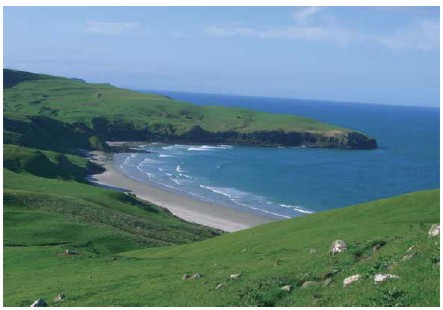
Figure 2.1: Coastal area of outstanding natural beauty. Otago Peninsula,
New Zealand.
The negative consequences of some of these changes to ocean and
coastal characteristics, as well as to coastal communities, include:
-
coastal erosion and flooding and damage to coastal habitats
-
increased water pollution, that adversely affect freshwater
resources
-
devastation to marine life
-
loss of unprotected dry land and wetlands
-
loss of exclusive economic rights over extensive areas
-
destruction of existing economic infrastructures and
commercial activities.
Multiple Use Conflicts in the Coastal Zone
Stakeholders from diverse economic and social groups share and
compete for space in coastal zones worldwide. Affluent commercial and
economically wealthy stakeholders have the potential to severely limit access to
resources for poor communities.
Coastal zones have many uses and serve many functions. These
areas provide natural, social and economic facilities that contribute to
increased quality of life, and the oceans are instrumental in determining
climate. A great variety of social and economic activity takes place in coastal
zones including:
-
tourism
-
commercial and recreational fishing
-
oil and gas development
-
habitats for endangered species, species breeding and resting
areas
-
groundwater recharge
-
water treatment; and
-
flood attenuation.
Coastal zones are also sources of community wealth, providing:
-
sources of food from animals, plants and fish
-
means of transportation
-
means of communication (e.g. cables)
-
areas for implanting fixed navigational installations (e.g.
lighthouses and piers)
-
areas for the dumping of waste materials; and
-
areas for scientific research on Earth’s basic physical and
biological processes.
The interaction of multiple uses in the coastal zone is
illustrated in Figure 2.2 showing the range of rights and restrictions in a
seamless information system for the land and sea interface.

Figure 2.2: Illustration of multiple interests in the coastal zone. Binns
et al. 2003.
In this context good governance is characterised by an acceptable
balance of stakeholder access to resources, ensuring that competing needs and
agendas can be met with as little conflict as possible. Managing this, is
difficult in an area that is dynamic, constrained by space, and is particularly
at risk to global changes whether these are driven by climate or economics.
Human Conflict in the Coastal Zone
Increasing urbanisation in the coastal zones can bring into
conflict the balance between economic development, the livelihood of local
communities, and protection of the natural environment.
Such conflicts may occur in a more extreme form where the natural
livelihood of the indigenous population and their access to the coastal
resources is taken over by economic interests. These include tourism and leisure
development that will not necessarily benefit the low-income people and the
local community. In this extreme form indigenous people are displaced from their
original spaces and places and may need to relocate in informal settlements with
limited basic ser-vices, unacceptable environmental conditions and few or no
work opportunities.
Many coastal communities live in, or are at risk from
socio-economic poverty. This can have a negative environmental effect upon
coastal zones with poverty driving resource overuse and ultimately,
environmental degradation. Coastal management policies should ensure equity in
terms of access to coastal spaces and other coastal resources and be underpinned
by pro-poor policy change and national poverty reduction strategies.
More generally, the disassociation of social systems from
ecological systems can also cause conflict. This has made it more difficult to
understand complex human-environmental interactions that occur when external
pressures such as increased tourism alter the existing balance.
FIG believes that a multiple use management in coastal areas
should be based on a principle of “social justice” where a balance is found
between the various interests of economic development, community livelihoods,
and environmental protection. Such a pro-poor approach to coastal zone
management is argued throughout this document.
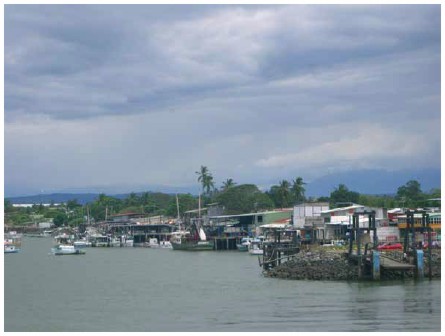
Local community harbour area, Pacific coast, Costa Rica.
3. Understanding the Concept of Resilience
Issues
The concept of resilience can provide a new and useful
perspective on sustainable development. At its core is the idea that development
processes should not and must not threaten the ability of future generations to
share the earth’s resources, as previous generations have been able to. State
and regional governments, multi-national corporations, local industry and the
in-habitants of the Coastal Zones are under increasing pressure to balance
economic growth with social responsibility, including respect for human rights
and traditional cultures. Furthermore, all organisations involved in Coastal
Zones and occupants of these areas are being asked to take greater
responsibility for their ecological “footprint”.
Resilience can be regarded as an operational tool for
recognising, improving and measuring corporate sustainability. Whilst the
definition of ‘Resilience’ may appear to be very close to the definition of
‘Sustainability’, they are not synonyms:
-
Resilience is basically about recovery and adaptation to
change while sustainability is mainly about survival and continuing
existence.
-
Resilience is stressing the importance of assuming change and
explaining stability; in-stead of assuming stability and explaining change.
There is an inextricable relationship between social wellbeing,
economic development and environmental sustainability as shown in Figure 3.1.
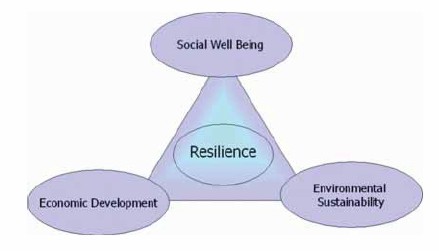
Figure 3.1: Relationship diagram between social wellbeing,
economic development and environmental sustainability.
Sustainability is often misinterpreted as a goal to which we
should all aspire. However sustain-ability is not a reachable state; it is one
fundamental characteristic in a dynamic, evolving sys-tem. Long-term
sustainability will occur as a result of continuous adaptation (resilience) to
changing conditions. It cannot be assumed that nature will be infinitely
resilient, and neither should it be assumed that it is possible to predict the
cycles of change that may occur in the future. A sustainable culture should be
based on a dynamic world-view in which growth and trans-formation are
inevitable. In such a world, innovation and adaptation will enable human
societies – and enterprises – to flourish in harmony with the environment.
A resilience approach accepts this interpretation of
sustainability. There is not one single stable state in a social-ecological
system, instead the system will be exposed to different ‘shocks’ that challenge
its fundamental identity and make it dynamic. A resilient system is able to
absorb shocks and adapt (and therefore remain sustainable) without changing its
fundamental structure and function. The concept of resilience needs to be at the
centre of strategic thinking about the actions that shape the future management
of the Coastal Zones. Resilience needs to be applied to people, agencies and
organisations as well as the environment. The lack of resilience in political
and governance processes and procedures is a major impediment to advancing
sustainability.
Land administration systems are the subject of constant change
and therefore require an in-built resilience to ensure they do not become
out-dated. Resilience of land administration systems can be understood by
looking at natural disasters such as hurricanes and tsunamis. The resilience of
a land administration system and how it is governed plays a key role in recovery
and reconstruction efforts following natural disasters. The resilience framework
is highly appropriate for trying to not only understand the role that land
administration systems have played in past disasters, but more importantly how
these systems can be strengthen to better support recovery and reconstruction in
future disasters.
There are many instances where projects come to an end without
having made provision for immediate succession planning. If development is the
managed process of change designed to improve the conditions of members of a
society, then sustainable development should balance the exploitation of
resources, the direction of investments and the advancement of technology in a
manner that affords the same opportunity to future generations.
Change is inevitable, to what extent can only be guessed, but
today’s generation should not be frightened of it, nor shrink from addressing
it. There is a need to change both the mindset and the toolkit for managing
change in coastal zones. Most importantly, every tool at our disposal should be
used for sound, effective, rational and unencumbered coastal management, rooted
in equity and a social justice framework.
The way forward
Pressure to develop the Coastal Zones will continue, the
challenge is to introduce mechanisms which will provide for equitable treatment
of all those who live, work or invest in them. One of the many challenges of
introducing resilience analyses is to define what constitutes the ‘fundamental
structure and function’ of a system.
The concept of protecting the rights of future generations seems
remote in the face of the many contemporary and often seemingly conflicting
business pressures. Typically many governments and businesses fear that the
creation of strategic policy on sustainability will simply involve expenditure
without any tangible result. There is a need to reinforce the message that
economic, environmental and social progress can be mutually supportive, and the
business case for sustainability rests on enhancing intangible value drivers
rather than directly generating financial profit.
There are real barriers to be overcome to ensure that the
concepts of resilience and sustainability are understood and translated into
strategy and policy; and then delivered by those working on the ground in
everyday practical decision-making situations. Using a new language that is
relevant to business interests, rather than relying on stakeholder pressures and
the moral force of arguments may overcome many of the barriers to the drive for
sustainability. This requires viewing the enterprise as closely allied to a
variety of social, environmental, and economic systems. This in turn
necessitates that land administration systems focus on parcels of land that are
undergoing the most change or which may be susceptible to change.
There is a need to bring together groups of government officials
and professional bodies and for them to take a holistic view of the strategies
and policies which impact on coastal zone management. In addition they need to
agree on the tools, mechanisms and information systems needed to inform
decision-making in all areas, from land and property tenure to marine ecology,
and overall spatial planning and development.
There is a need to ensure that capacity building is undertaken at
all levels in countries that are managing the Coastal Zones; within Universities
and Continuing Professional Development (CPD) or Life Long Learning (LLL), and
in a number of associated professions – Architects, Engineers, Land
Professionals (this includes, Land and Hydrographic Surveyors, Cadastral
Experts, and Environmental Surveyors), Lawyers and central and local government
(municipality) officers.
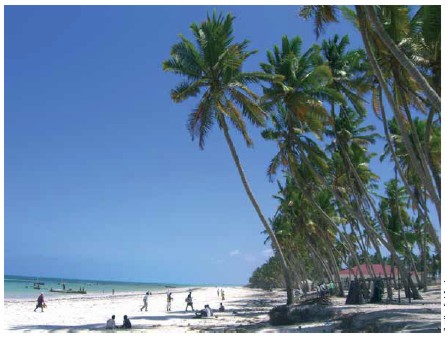
Zanzibar, East Coast.
4. Managing Land Tenure and Property Rights
in Coastal Areas
Issues
The rights of property and the land tenure in the coastal zone
can often be subject to different legal jurisdictions. The general objective is
to regulate and to guarantee access to different interest groups. However, the
reality is that this results in considerable conflict, disputes, claims and
counter claims associated with land tenure.
Drawing from experience in Costa Rica, this section deals with
three aspects related to the rights of property and the land tenure in the
coastal zone:
-
Different types from property rights and land tenure;
-
Conflicts through legal contradictions in land tenure; and
-
Activities of land professional attempting to bring about
harmonious interaction between the administration of and sustainable human
development in coastal zones.
“The public” character of the coastal zone
The sea has always been of strategic importance in the
organisation of societies. Access to the sea and the consequent control of the
coastal zone were essential for the consolidation of many countries.
In the past century, many states, using different legal
mechanisms, sought to consolidate the governmental function of the coastal zone.
This was designed to ensure that access to all citizens was guaranteed and
different uses permitted. In many cases consolidation of land and property
rights created tension between existing owners and the demarcation of other
interests, for example parks and national reserves.
In many countries, mainly of the third world, the coastal zone is
subject to various interests. Each of these base their understanding of their
rights on different laws or their own particular interpretations of the law. The
resolution of these issues is far from transparent, creating a situation where
the insecurity and precarious day to day living of many vulnerable people makes
development difficult.
Different rights from property and land tenure
The ideal situation, where the government provides for universal
access to the coastal zone, contrasts with the reality where different groups
claim the right to occupation. The reasons can often be traced back to different
legal frameworks and historical traditions between three groups: settlers,
concessionaires and the owners.
Settlers
The coastal zone has been occupied or possessed for centuries.
Once the state introduced regulations concerning access and use, the rights of
those occupants or settlers was recognized. Recognition of settlers’ occupation
can apply to individual or communal property. This ensures that traditional or
indigenous groups are guaranteed land or territories by the states to enable
them to preserve their customs and means of subsistence.
Concessionaires
The concessionaires are those who have agreed to a legal
framework and obtained a use right to public property that is regulated. These
use rights permit some activities by the concessionaires whilst restricting the
use by others.
It is under this approach that the tourist industry, from large
complexes to small family units, has been developed. This also stabilises other
activities for example traditional or artisan fishing.
Owners
Despite the generalised concept and public character of the
coastal zone, in some cases the State recognises individual property rights
which encourage the owners to come forward.
The recognition of legally secure private property in lands of
the coastal zone, is often based on older laws, approved prior to the official
regulations of the coastal zone. For example, in Costa Rica, titles granted by
Spanish Crown at the time of colonisation are still recognised. These rights of
property find greater endorsement in the countries that have consolidated and
respected systems of land estate recording.
Weaknesses of the different systems of property rights and land tenure
The regulation of the land tenure and property rights in the
coastal zone presents significant weaknesses that require attention. These
weaknesses originate from different legal frameworks that are generally
contradictory and can be out of step with the reality of the occupation in the
coastal zone. The management of the coastal zone can be shared by several tiers
of government causing confusion between the institutions and sectors of society.
Generally property or land tenure disputes occurring in the
coastal zone arise because there is no clear identification and boundary of
rights of property or possession. In most cases the Institutions of the State do
not have appropriate information systems and those that do exist show little
clarity in showing the boundary of the rights of different groups.
A consequence of this lack of clarity on the rights of
proprietors, concessionaires and settlers, is the emergence of a new player,
“the occupant”. The confusion in the legal rights associated with the coastal
zone allows “anyone” to allege rights, and to establish occupation with the
purpose of making use of the land for a variety of interests.
There is an urgent need for the state to create territorial
information systems, which allow for the control of the coastal zone within an
agreed legal framework thus enabling holistic decision-making.
Land tenure possession, formal and informal
Today the state is not the absolute owner of the coastal zone and
there are both formal and informal levels of occupation and use of rights. In
general formal possession is based on legal mechanisms that the state has
established to allow the possession by individuals; and on the other hand
informal occupants have no legality and are unable to exert pressure to protect
their rights within the coastal zone.
There is a need to make a clear distinction between informal and
formal rights and occupation thereby providing formal rights to proprietors,
concessionaires and settlers, endorsed by the legal frame that guarantees their
right. Figure 4.1 shows this simple separation.

Figure 4.1: Ideal separation between formal and informal possession.
There are also problems with the informal rights. In the Third
World Countries the systems of right of property and land tenure are not always
transparent and some people allege rights that have been granted by one
institution of state that are then not recognised by another. This mainly occurs
where there are traditional settlers or indigenous towns in the coastal zone.
The reality is that, with the enormous interest in the coastal
zone, the diversity of administrative controls used by the state means that the
line between formal and information rights becomes diffused. The result is shown
in Figure 4.2.

Figure 4.2: Realistic separation between formal and informal possession.
The separation between formal and informal varies in different
countries, according to the legal framework that regulates the property rights
and land tenure in the coastal zone. Even within the same country, regional
differences in the level of formality are often found. The difficulties in
determining legal property boundaries are exacerbated by a lack of clarity about
the exact physical extent of what is included or excluded from the coastal zone.
The way forward
In order to reach a harmonious, sustainable and resilient
development of the coastal zone there is a requirement to approach the issues
holistically. Three of the key factors that will maximise the effective
management of these areas are:
-
The creation of a uniform Cadastre following the key
guidelines in FIG Cadastre 2014 declaration 1 – “the cadastre will indicate
the complete legal situation of territory, including public right and
restrictions”.
-
The creation of, and implementation of, a Land Information
System to bring together all information sets that impact the costal zones.
These critical data sets would enable co-ordination of strategy and
planning, and these would include:
-
land tenure (Cadastre) Marine Cadastre, especially in
river deltas
-
land and property rights (continuum of rights in a broad
approach, including public land)
-
customary and indigenous rights
-
marine management
-
access rights
-
transportation
-
bio diversity.
-
The use of Land Professionals in facilitating and bringing
together all professional groups and tiers of government.
There is also the need for the institutional reform of those
organisations responsible for the coastal zone, ensuring a prioritising of
policy issues and overall coordination.
The diverse skills of Land Professionals enable them to play an
active roll in the promotion and development of Land Information Systems. In
addition their multi-disciplinary facilitation skills provide the opportunity
for them to bring together those responsible for the administration of the
coastal zone and the local and indigenous people who often feel disenfranchised.
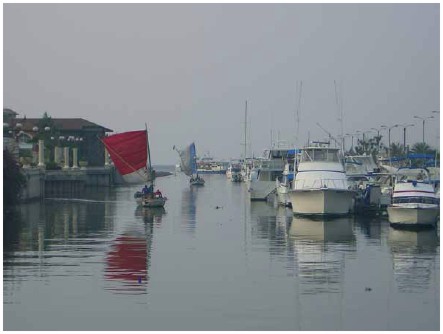
Jakarta, Indonesia
5. Managing Access to Land in Coastal Areas
Issues
The physical resources in the coastal zone have a dramatic
influence on people and the distribution of population including the tourist. In
developing countries existing communities are be-coming increasingly
marginalised, and in environmentally attractive areas access is one of the most
important challenges of coastal and marine management.
Finding a sustainable answer to the issues of maintaining access
to these areas requires coordination of long term planning and management of
recreation and tourism. The resources that have provided the foundation for
economic development in the coastal region are now in jeopardy. Without
appropriate intervention the outlook for these areas is one of declining human
welfare, declining resources and increasing use conflict.
Social Justice
The quality of life in coastal communities is inextricably linked
to the quality of the coastal and marine resources. Levels of poverty are
increasing in these areas, evidenced by decreasing fish catch, destructive
fishing practices, and an increasing volume of untreated sewage and nutrient run
off released into near shore areas.
Usually human activities relating to land use are regulated on
the basis of subdividing an area or a resource, and then allocating subunits for
different purposes. This is not an option available for coastal lands and their
resources, due to the highly prized, yet fragile nature of the resource.
It is unacceptable to alienate existing and often increasingly
poor communities from coastal re-sources. Social justice is politically
necessary and to achieve this requires a joined up community approach that
combines policy with action on the ground to conserve coastal resources for
access by all community groups. In order to deliver a jointly agreed and
sustainable future for all society, Coastal Zone Management frameworks need to
combine a strategic focus found in land administration. The resulting strategy
should provide a management framework for a holistic programme, and a vision of
integrated management for the coastal zone.
Land, sea and people need to be better managed in a spatial
sense. Coastal Zone Management is inevitably a complex process, but this
paradigm requires change, and needs to recognise the multiplicity of issues
including resource use, capacity, administration, registration of rights and
planning.
The management task is to balance economic development, social
needs and environmental protection. Within land administration this is a
function of spatial planning and development.
Distribution of economic resources, and consequently the ability
to manage resilience, is very different in the north to countries in the south.
In the north, an industrial and now post-industrial society, such impoverishment
of our local resources is counterbalanced by massive inflows of resources of
every kind from other regions of the world. However, for many societies
experiencing the same coastal transformation process today, such flows of goods,
and the subsidies that have underwritten the cost of development, are nowhere on
the horizon. Specifically public and private use may be in conflict in
ecological areas that appeal to tourists seeking a ‘pristine’ beachside
environment for the purposes of holiday, leisure and recreation in tropical
destinations.
As these communities are growing, there is increasing pressure on
the capacity of the environments to sustain even the increasing village
communities. Tourism development and disaster protection are two key conflicts
in Central America and small island states which relate to both physical and
economic vulnerability, and completely undermine local communities.
Tourism development
Coastal and island states are experiencing increasing pressure on
land and their resources but the economic benefits, particularly tourism and
related development are not necessarily benefiting low-income people. In some
instances these people are displaced from their original spaces and have no
option but to relocate and settle in informal settlements with limited basic
services, unacceptable environmental conditions and few or no work
opportunities. A typology is emerging that tourism is reducing access to
resources for the local community and is further impacting on fragile resources.
Recreation is one of the largest and fastest growing uses of the
coastal zone. Through tourism some of the leisure and recreation needs of
affluent and largely urban communities may be fulfilled at distant locations.
Coastal tourism development is a legitimate goal, with many private sector
schemes proving to be reasonable from a conservation or preservationist
perspective. Tourism can provide the motivation for conservation and community
level decision-makers to appreciate the values of high environmental quality and
attractive local community goods and services. It can generate long-term economy
and social benefits locally, nationally, and for the global community.
However, a proliferation of private sector developments has
proven to be irresponsible from a conservation, preservation or community
perspective.
Tourism has resulted in alien values being imposed upon long
established local communities who rely on marine resources for their
livelihoods.
Disaster protection
Historic settlements and new urban development are often located
in some of the most beautiful natural environments in the world. These urban
developments and settlements were largely un-planned, encroaching on the
beaches, water bodies, wetlands, and wildlife sanctuaries.
Increasingly, coastal destruction and extreme weather events have
introduced a new and disruptive dimension to coastal zone management: a risk to
the coastal balance of land use, to communities living on the coast, fisheries,
the tourist industry, infrastructure, and buildings. The risk falls
disproportionally onto the poor. Indigenous coastal communities, often as a
result of tourism development, are built on marginal land such as flood plains
and coastal swamps, making poor people particularly vulnerable to events such as
flood, storm surges and fire.
The effect of climate change on human settlements could have been
minimised by urban planning. Early warning systems are being set up, but
alongside this, more attention needs to be paid to improving the planning of
human settlements.
Assessing risk requires both building community resilience in a
rapidly urbanising world, and exploring the extent to which property rights
(public, common and private) and property economic tools could combine and meet
the objectives of sustainable development through public private partnerships.
In the aftermath of natural disasters, the urgency of livelihood
and habitat restoration adds a new dimension to coastal zone management issues
including alleviating poverty, reducing environmental degradation and enforcing
set back lines. Planners should identify immediate tasks in which the local
community members can become involved; both to earn a wage and ensure coastal
habitats are restored as quickly as possible.
The way forward
Social justice must be the outcome of the interaction between
communities living in coastal zones and their need for access to resources in
competition with both the extractive and tourist industries.
This raises a number of issues that need to be addressed
including:
-
rights of access for coastal communities to marine resources
-
viability and social status of communities in the coastal
zone
-
provision of power, capability and rights of communities to
engage in decision making in cases of conflict
-
reassessment of the role of Central or State government and
local jurisdictions in multiple use management, for example when overseas
tourism developments alienate local communities
-
the redefinition of the Coastal Zone Management paradigm in
respect of land administration.
The way forward is to develop an appropriate a balance between
resource development for communities and resource protection. Cases of
development conflict are often about public and private sector relationships and
the nature of associated property interest.
Development has to be a process that takes account of the
multiplicity of issues in coastal areas while being embedded into a social
justice paradigm.
This application of land management links land to social justice,
and accommodates the original coastal community and their need for resource
access in the face of the economically powerful tourism and leisure community.
6. Managing Use and Allocation of Land in
Coastal Areas
Issues
There is considerable concern over the conflict of space between
the local community and the increasing pressure of tourism development in the
Coastal Zone. There is a need to utilise, and where necessary develop practical
management tools that recognise social justice and the living conditions of the
poor.
Multiple Use Management
Achieving the balance between competing uses involves
understanding the multiple uses that occur in a relatively confined space and
requires a spatial approach for effective management. Concerted action is needed
both to correct past mistakes and to ensure sustainability and resilience into
the future. The continued decline of these same resources is due to poorly
coordinated enforcement and unplanned resource exploitation.
Spatial concepts can be used to highlight the
inter-relationships, nature and proximity of people and uses within the linear
constraints of the coastal zone. The nature of conflicts will vary; some uses
are in competition for the same resources, others may conflict in time and space
only. To make multiple use management operate successfully, there must be
greater knowledge of the relationship between economic and social use. In
addition investment must be made in the appropriate technologies to use the data
efficiently.
Direct users of the marine environment such as fisheries and some
forms of recreational and tourism benefit from, and are affected by, the
maintenance of environmental quality. Unless short term economic outlook for
their industry is poor, they are likely to be concerned about any reduction in
quality. They are likely to accept, at least in the long term, management
measures that maintain the productive natural qualities of a marine environment.
Managing the inter-relationship of multiple community objectives
takes into account different community perspectives of coastal resources linked
to the conservation of that resource. This perspective depends on subjective
judgements concerning the amenity value of the environment, and covers a broad
range of intentional human interactions with biological resources and natural
areas. Articulating this value reveals fundamental differences of opinion around
the relationship between humans and the natural environment. These differences
often reflect the degree and nature of economic dependence upon the resources of
natural areas.
Multiple use management approaches may be summarised in a diagram
Figure 6.1 which illustrates the area in which a decision or group of decisions
will conform technically with a requirement to address the concerns of three
interest groups: conservation, tourism and livelihood/ fishing. The mid-point of
the ‘Equality Triangle’ represents the ‘perfect’ solution.
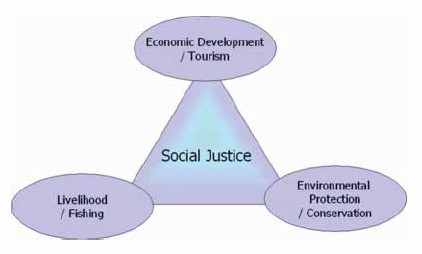
Figure 6.1: The ‘Equity Triangle’, for Access to, and sustainable use of,
coastal resources.
Social justice is a product of the way society is organised and
is affected by competition for ac-cess to coastal resources for livelihood on
the one hand, and for leisure tourism on the other, as outlined in the equity
triangle.
The three corners of the equity triangle work as competing
forces. In general, tourism looks to amenity value, while local communities will
value their livelihoods.
Economically there is a stark contrast in the relative affluence
and life styles of tourists and members of the local community. This has the
potential to provoke discontent and unrest. The tourism industry can mitigate
against this by ensuring that local communities reap some of the benefits of
tourism. Conflict can also be reduced by maintaining access to the common
resource of the sea for both communities living in coastal zones and tourists.
This demands a holistic approach such as land administration and
spatial planning tools to support Coastal Zone Management.
Management tools
Planning is only the first step in management – it is not an end
in itself. Integrated Coastal Zone Management from a land use perspective
requires both understanding of the planning and land administration process.
Initially there is a need to acknowledge that a problem exists, and that tools
are required to control and administer resource conflict and use within a
functional area of highly interdependent uses.
Spatial tools must be pro-poor and practice-based. Many
practitioners accept that in the real world some compromises are always going to
be required. National and local governments need to be seen to protect all their
citizens and ensure that economic power does not override indigenous rights and
needs.
In Land Use and Development planning there are a range of tools
that can be used to support decision making, these include:
-
policy approaches to address multiple uses over the coastal
zone or space, including existing poor communities that are increasingly
becoming marginalised and disaffected from the resources available in the
coastal zone
-
proposed strategic management framework(s) that will bridge
economic development, community and environmental protection issues
-
stewardship of land and marine resource
-
technologies such as Geographic Information Systems (GIS) and
satellite imagery
-
shoreline management plans based on catchments that considers
natural physical processes
-
planning policy tools, such as development set back lines
-
achieving unity of vision through master planning – a spatial
planning process that sets out a plan for the future development of an area
and community education.
The challenge is that sustainability and resilience requires
community engagement, for rich and poor alike. This will require tools that
foster collaboration, access capacity building, and education.
The way forward
A change in culture is required to encourage those who are
responsible for the Coastal Zones to understand the larger complex issues and
adopt flexible and adaptable processes and policies. There is a need to develop
systems in preparation for rare but devastating events; to use a combination of
instruments; get all stakeholders involved; and to develop local solutions to
local problems. Progress can only be made if the ability exists to deliver
Coastal Zone Management at various scales from regional, national to local
levels and be adaptable to a range of circum-stances.
Effective planning requires a local, bottom up approach building
from two bases: the ecological basis of the best available understanding of the
natural system and processes of the area – this means engaging with local
knowledge; and the socio-economic basis of the needs and expectations of those
who use or value the resources of the area. This often requires research and
community education in order to demonstrate cause and effect of human impacts
and to establish that management has the potential to halt or reverse decline in
amenity.
Good governance is required to maintain a strategic, global view
interacting with the international community, on forces that pull, such as the
environment, but also forces that push – in the case of tourism markets. At the
local level cash income generated by tourism, should be diverted to support the
involvement of communities in planning for post disaster rehabilitation,
disaster risk reduction and the design of more disaster resistant settlements.
Land Professionals are ideally placed to work with all parties to
facilitate solutions to the complex planning issues in the Coastal Zones. The
outcomes of this facilitation should aim to be:
-
Based on local economies with much more emphasis on social
responsibility. Local solutions to planning and environmental management
would be encouraged. There would be local community partnerships,
potentially with international corporations, with some profits from tourism
channelled back into the local community. A substantial, high degree, of
local capacity leadership building will be required to foster equitable
community managed access to resources.
-
Supporting global sustainable development with a high
emphasis on international action and international obligations. This
requires a strong commitment to regulation and more proactive management of
resources and landscapes. Coastal and Marine regional proto-cols signed up
by States would be emphasised. Although good for marine and coastal
biodiversity, it requires a parallel community policy approach to land and
resource management.
A strategic framework for effective policy and programme
development is required to achieve a fully integrated Coastal Area Management
process and investment in spatial technologies and data sets.
Awareness of the resources and their protection is increasing,
and leading to an increase in the number of conservation activities. Government
agencies, NGO’s, community based organisations and indigenous communities need
to play a pivotal role in managing coastal assets. Any coastal initiative should
be concerned with including these groups to the extent that collaborative
partnerships are developed. Sustainable coastal development can only be achieved
when the governance process responds to, and is accountable to, the people who
live with the results.
Ultimately, the impact of the tourism population pressure on
people’s lives can be greatly reduced by effective forward planning and
governance, but this will require adherence to the principle of social justice.
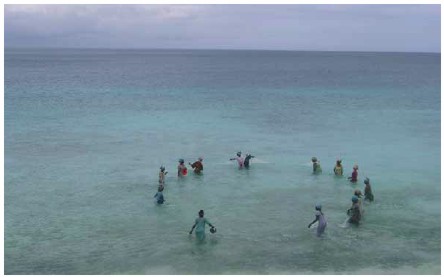
Zanzibar, East coast.
7. Building the Institutional Capacity
Issues
In many countries, including Costa Rica, there is no single agency
responsible for the management of the coastal zone, and in some cases no
specific level of government with responsibility for all aspects of strategy and
management. This makes it more difficult for governments and institutions to
respond to the complexity of issues involved.
The result can be indecision, and contradictory legislation and decision
making, leaving those responsible for the management of the areas confused and
without clear and effectives means of redress, or ability to challenge what they
see as an impenetrable institutional body. In tropical zones many new houses are
being constructed as holiday homes for foreign nationals who re-side in them for
only part of the year. This places pressure across all aspects of the local
economy. Good planning and legal frameworks are required to provide a balance
between inward investors, the indigenous population and environmental
protection.
Good governance is based on recognition of the interests of all stakeholders
and inclusion of their interests where possible. Interests can be expressed in a
variety of ways, for example: sovereignty, jurisdiction, administration,
ownership (title), lease, license, permit, quota, customary rights, indigenous
rights, collective rights, community rights, littoral rights, public rights,
rights of use, and public good. Coastal states are challenged with managing the
multi-dimensional tapestry of these interests (and perhaps others) on the coast
and offshore. Over the next few decades those responsible for marine policy and
administration will be challenged with trying to understand this tapestry and
communicating it to the various decision makers and stakeholders. However,
addressing the complexities associated with these interests solely from a
boundary delimitation perspective does not necessarily improve the governance of
marine spaces.
The many people who have settled in coastal zones to take advantage of the
range of opportunities for food production, transportation, recreation and other
human activities deserve the benefits of good governance. All too often, coastal
zone management has simply become a process of managing or at best mediating
conflicts between the multitude of users of what can be scarce resources, and
addressing current problems that result from stakeholders pursuing their own
sectoral interests. The ‘status quo’ may be maintained in order to avoid
conflict, al-though there is a potentially large risk that this apparent
stability is not sustainable and could collapse if society cannot make the
social, economic and political changes necessary for survival.
In spite of many local and national efforts, traditional approaches to the
management and use of coastal resources have often proved to be insufficient to
achieve sustainable development. The professional institutions have been unable
or unwilling to provide the conditions that could facilitate development,
stimulate progress and encourage a change in institutional behaviour in order to
achieve shared goals.
There is a real need to determine mechanisms which will ensure coordination
between national, regional, local governments (municipalities) and professional
institutions.
Traditional government structures are often committee based and slow in
making certain strategic decisions. A holistic approach to decision making is
required to ensure that all parties are involved and represented and that an
effective means is established to ensure that decisive decisions are made.
The Way Forward
- Ensure that there is a single agency of government responsible for the
entire management of the coastal zone. This agency should have the legal
responsibility for resolving is-sues of overlapping and coexisting rights
and tenures and bring together a coherent strategy and policy for the areas
that will enable contradictory legal issues to be equitably re-solved. This
may require reform of responsibility and re-engineering of processes and
procedures to enable changes to be implemented. A political champion
‘visionary’ will be required to bring together and harness the appropriate
politicians whose support will be required to implement the initiatives.
- Integration of programmes and plans bringing together economic
development, environ-mental management and land use. There is a need to
develop integration and coordination for various tasks of management amongst
all levels of government (local, state/provincial, national and regional),
as well as between the public and private sector.
- Review existing legal frameworks and plug loopholes that enable the
courts to be over burdened with cases caused by legal challenges to planning
decisions.
- Professional bodies whose members are used to advise government and
politicians should use international best practice and actively engage with
the political process of change and empowerment.
- An indigenous organisation that works closely with the single agency
should take the lead in the design of their own infrastructure. This will
required political will and financial in-vestment. In the context of
developing countries the process of modifying institutional frameworks can
be complicated by the presence of donors and consultants from different
countries who all have their own perspective and interest. Enthusiastic
professionals naturally gravitate toward the best solution. In practice the
management of reduced and achievable expectation by various professionals
may well be pragmatic, sufficient and more sustainable in the longer term.
8. Building the Professional Capacity
Issues
There is a growing awareness of the issues surrounding the Coastal Zones and
the conflicting pressures on these fragile resources. Nations are generally now
more conscious of the fact that the actions of individuals can have global
consequences.
The development of Land Professionals is key to the vision of sustainable and
resilient development of the Coastal Zones – a major challenge but one that is
essential if change is to be achieved. This requires the acceptance by other
associated professional institutions of the skills and abilities of the Land
Professional. The Land Professional is required to possess a large knowledge
derived from high level education and practical training. These Professional
skills are important to the well being of society. Professionals are expected to
utilise their independent judgment in carrying out their professional
responsibilities and they are regulated by ethical standards. Land Professionals
are expected to place the interests of society above these of the individual
member. This is important in developing the trust of all those involved in the
Coastal zones.
The development and maintenance of the Professional capacity is illustrated
in Figure 8.1.
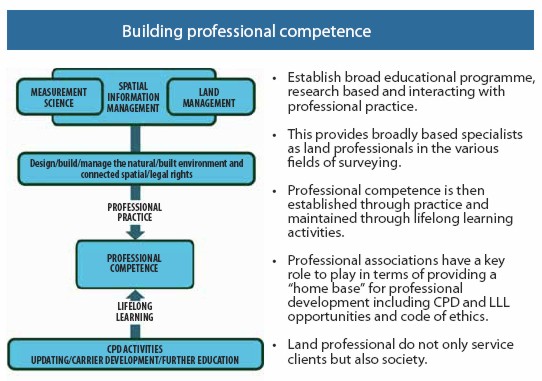
Figure 8.1: Land Professions Capacity Model. S. Enemark.
The Land Professional, together with those of other related Professional
disciplines, needs to be conscious of the fragility of the coastal zone in order
to influence decisions. There are two fundamental aspects that guide the
development of the Land Professional:
- Continuing Professional Development (CPD) or life long learning (LLL),
that ensures skill, such as e-learning and ICT are up to date and, in
particular, all aspects of Coastal Zone management are subject to ongoing
reassessment. Professionalism relies increasingly on an ability to respond
quickly to changing market conditions, to client requirements and to the
influences of government policies; and
- the development of high levels of ethical standards for Land
Professionals, and other associated disciplines, is essential to support the
development and continuous implementation of appropriate ethical standards
of behaviours in the Coastal Zones.
Continuing Professional Development and Life Long Learning
There is a requirement for all Land Professionals to ensure their skills are
permanently up-to-date and appropriate for the work they undertake. In the
coastal zones, in addition to the direct skills that are required for their
specialism, all professionals should ensure that they develop and maintain
skills incorporating the ethical issues with which they need to engage,
including the needs and rights of indigenous and minority groups.
The coastal zones require Land Professionals to strictly adhere to the
principles of sustainability and resilience in order to promote balanced
development and facilitate the coexistence of different users and the
environment.
In developing countries in particular, major corporations and the Land
Professionals can act together to promote a consciousness in all professional
groups that recognises the pressures on the real estate market, and the need to
create a vision of social development that incorporates a balanced approach to
the development of the environment.
Professional ethics
One consequence of globalisation and the opening up of markets to foreign
participation is the need for professional and ethical standards that apply to
all. This is to ensure fair competition, to build and retain the confidence of
clients, to protect the environment, and to respect the interests of third
parties.
One mark of a Professional Institution or Organisation is that its members
are subject to a code of ethics. These codes of practice are generic and it is
necessary to be able to put theory into practice. Ethical standards should be
monitored and enforced to ensure that they are being appropriately applied in
practice.
Courses and case studies need to be developed that show best practice in the
application of codes of ethics in practical situations. This requires a
commitment to bring together the under-standing of ethics in a number of
dimensions: social, technological, administrative and environ-mental. This
practical understanding can then ensure that appropriate ethical standards are
applied to sustainable and balanced development of the coastal zone.
The practical complexity of applying ethics must be at the core of Land
Professionals’ daily activity. In sensitive and fragile areas such as the
Coastal Zone the balance between one course of action or decision and another
requires careful assessment of often conflicting priorities.
The Land Professionals skills should not be confused with those of the
technician – to set out boundaries or parcels. The Land Professional’s ethics
perspective covers a wide and eclectic set of disciplines which can support the
bringing together of different professional groups, and facilitate or mediate
outcomes beneficial to all parties. This entails commitment beyond the con-fines
of a specific project.
The way forward
Given the financial and organisational constraints facing institutions and
groups involved in the coastal zone, innovative ways to maximise learning and
increase knowledge must be introduced. There is a need to ensure that both
professional institutions and corporations promote understanding of the issues
that surround the Coastal Zones. This should promote a detailed understanding of
the complex balance of competing interests that include social dimensions.
All professional institutions, state administrations and corporations should
ensure that their staff are encouraged to maintain and update their skills and
understanding of the issues associated with the Coastal Zones.
A commitment to Continuing Professional Development (CPD) and Life Long
Learning (LLL) is essential to the work of all Professionals throughout their
career in order to extend their knowledge, skills and experience. There must be
a conscious effort to bring about an environment where this practice becomes
accepted behaviour.
Land Professionals and all professional groups whose work impacts the
activities within the Coastal Zones should discharge their professional duties
in accordance with a model code of professional conduct and adhere to ethical
principles. Courses must be provided to ensure that ethical codes are introduced
(where they are currently unavailable), and practical case studies are used to
enable participants to become proficient in putting theory into practice.
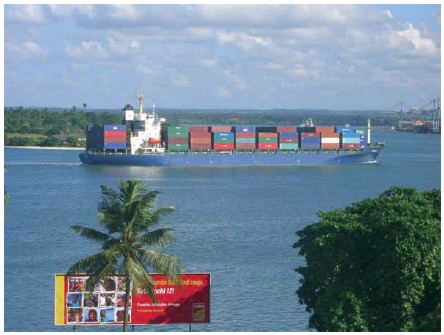
Dar es Salaam harbour, Tanzania
FIG definition of Surveyor – The Land professional
A surveyor is a professional person with the academic qualifications and
technical expertise to conduct one, or more, of the following activities;
- to determine, measure and represent land, three-dimensional objects,
point-fields and trajectories;
- to assemble and interpret land and geographically related information,
- to use that information for the planning and efficient administration of
the land, the sea and any structures thereon; and,
- to conduct research into the above practices and to develop them.
Detailed Functions
The surveyor’s professional tasks may involve one or more of the following
activities which may occur either on, above or below the surface of the land or
the sea and may be carried out in association with other professionals.
- The determination of the size and shape of the earth and the measurement
of all data needed to define the size, position, shape and contour of any
part of the earth and monitoring any change therein.
- The positioning of objects in space and time as well as the positioning
and monitoring of physical features, structures and engineering works on,
above or below the surface of the earth.
- The development, testing and calibration of sensors, instruments and
systems for the above-mentioned purposes and for other surveying purposes.
- The acquisition and use of spatial information from close range, aerial
and satellite imagery and the automation of these processes.
- The determination of the position of the boundaries of public or private
land, including national and international boundaries, and the registration
of those lands with the appropriate authorities.
- The design, establishment and administration of geographic information
systems (GIS) and the collection, storage, analysis, management, display and
dissemination of data.
- The analysis, interpretation and integration of spatial objects and
phenomena in GIS, including the visualisation and communication of such data
in maps, models and mobile digital devices.
- The study of the natural and social environment, the measurement of land
and marine resources and the use of such data in the planning of development
in urban, rural and regional areas.
- The planning, development and redevelopment of property, whether urban
or rural and whether land or buildings.
- The assessment of value and the management of property, whether urban or
rural and whether land or buildings.
- The planning, measurement and management of construction works,
including the estimation of costs.
- In the application of the foregoing activities surveyors take into
account the relevant legal, economic, environmental and social aspects
affecting each project.
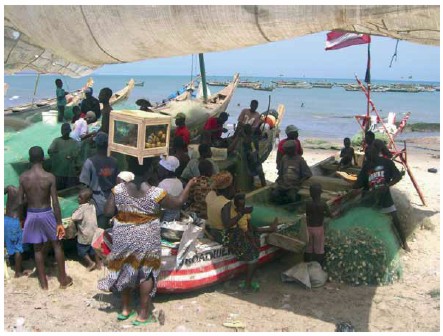
Ghana, south coast
|


























